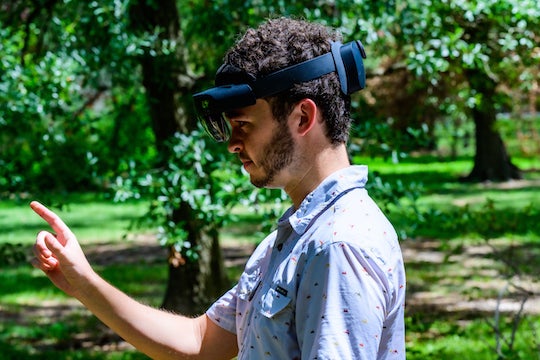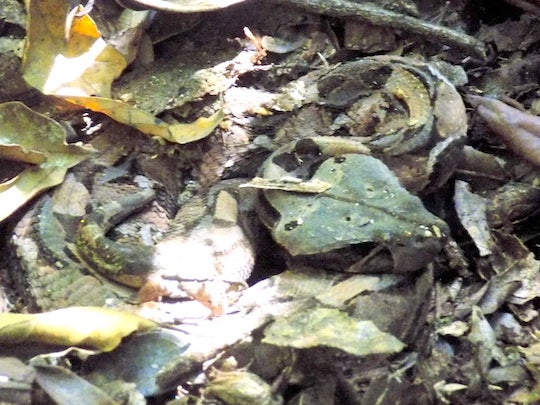By Carlyn Chatfield
Special to Rice News

Rice University scientists used a commercially available mixed-reality headset with custom-designed software to measure and analyze forest floor vegetation, demonstrating a correlation between animal diversity and the mapped habitat of a Tanzanian national park. According to the paper published in the journal Ecology, the greater the microhabitat surface area, the richer the biodiversity of its mammals.
Traditional habitat field research requires a significant amount of time and effort, but Rice postdoctoral researcher Daniel Gorczynski reduced those costs by incorporating a Microsoft HoloLens with his innovative VegSense software. Gorczynski and his advisor, assistant professor of biosciences Lydia Beaudrot, created VegSense to help researchers measure animal habitats, while the HoloLens was initially designed to improve work quality and outcomes in manufacturing, engineering, healthcare and education.

“Because the HoloLens is a mixed-reality device, you can see both the projected mesh over the forest structure as well as your local surroundings,” Gorczynski said.
Working in Tanzania’s Udzungwa Mountains National Park, Gorczynski partnered with scientists from the Udzungwa Ecological Monitoring Center and the University of Florence in Italy to leverage his VegSense shape and configuration measurements from the forest floor with data from motion-activated trail cameras set to observe mammal populations in the park.
“We identified 31 points within the protected forest to collect paired camera trap and HoloLens data and used a novel type of model to assess the statistical relationship,” Gorczynski said. “We found that mammal diversity did indeed increase with forest floor habitat surface area as measured by the HoloLens.”

Not only did the number of mammal species increase at locations with high habitat surface area, but the species also presented a greater variety of ecological characteristics, such as greater variety of body sizes and dietary requirements. Gorczynski hopes these results will encourage more focused efforts to designate high surface area habitats as protected.
“Tropical forests have some of the most unique and diverse mammal communities on earth,” Gorczynski said. “In these forests, mammals perform lots of important roles that help maintain the ecosystem, such as dispersing seeds, moving nutrients through the ecosystem and controlling the populations of other species through herbivory and predation.”
Gorczynski said the HoloLens is easy to learn to use. He has taught several scientists, technicians and students in Tanzania and Madagascar to incorporate it in their data collection, and he is already imagining potential collaborations where the standardized, scalable data accumulated through a HoloLens could be used in tandem across multiple sites.

“Dan knew he wanted to study mammal functional diversity and hit the ground running when he joined my lab,” Beaudrot said. “He wasted no time diving into his first research project in his first month and proceeded to publish five first-author publications during his Ph.D., including this final HoloLens paper in one of the leading journals in our field.”
Chia Hseih, a Rice graduate student in ecology and evolutionary biology, is also an author on the paper.
The research was supported by the National Science Foundation (2213568), Northrop Grumman, Conservation International, the American Philosophical Society, Sigma Xi, Diane McSherry, Patrick Poe and others. Camera trapping was funded through a grant from the Aage V. Jensen Foundations, Fondazione Foresta Futura, MUSE — Museo delle Scienze and other donors.
- Peer-reviewed paper:
-
“Tropical forest mammal occupancy and functional diversity increase with microhabitat
surface area” | Ecology | DOI: 10.1002/ecy.4181
Authors: Daniel Gorczynski, Francesco Rovero, Arafat Mtui, Steven Shinyambala, Joseph Martine, Chia Hsieh, Luke Frishkoff and Lydia Beaudrot
https://doi.org/10.1002/ecy.4181 - Image downloads:
-
https://news-network.rice.edu/news/files/2023/10/HoloLens_view_LG.jpg
CAPTION: Rice University’s open-source VegSense app for the Microsoft HoloLens headset allows researchers to record data about vegetation they see as they walk through a field site and create downloadable files for later analysis. (Photo by Brandon Martin/Rice University)
https://news-network.rice.edu/news/files/2023/10/JWF_8945.jpg
CAPTION: Rice doctoral alumnus Daniel Gorczynski wearing a Microsoft HoloLens headset. (Photo by Jeff Fitlow/Rice University)
https://news-network.rice.edu/news/files/2023/10/JWF_9016.jpg
CAPTION: Lydia Beaudrot is an assistant professor of biosciences at Rice. (Photo by Jeff Fitlow/Rice University)https://news-network.rice.edu/news/files/2023/10/GaboonViper-by-DanielGorczynski-DSCN0723.jpeg
CAPTION: A Gaboon viper amid leaf debris in Tanzania. (Photo courtesy of Daniel Gorczynski)
- Related stories:
-
Study finds human impact on wildlife even in protected areas:
https://news.rice.edu/news/2023/study-finds-human-impact-wildlife-even-protected-areasVegSense makes sense for forest studies
https://news.rice.edu/news/2022/vegsense-makes-sense-forest-studies - Links:
-
Ecology and Evolutionary Biology graduate program: https://biosciences.rice.edu/ecology-and-evolutionary-biology-graduate-program
Beaudrot research lab: https://lydiabeaudrot.weebly.com/
Department of Biosciences: https://biosciences.rice.edu/
Wiess School of Natural Sciences: https://naturalsciences.rice.edu/
- About Rice:
-
Located on a 300-acre forested campus in Houston, Rice University is consistently ranked among the nation’s top 20 universities by U.S. News & World Report. Rice has highly respected schools of Architecture, Business, Continuing Studies, Engineering, Humanities, Music, Natural Sciences and Social Sciences and is home to the Baker Institute for Public Policy. With 4,552 undergraduates and 3,998 graduate students, Rice’s undergraduate student-to-faculty ratio is just under 6-to-1. Its residential college system builds close-knit communities and lifelong friendships, just one reason why Rice is ranked No. 1 for lots of race/class interaction and No. 4 for quality of life by the Princeton Review. Rice is also rated as a best value among private universities by Kiplinger’s Personal Finance.

